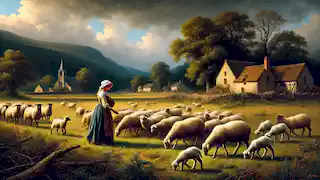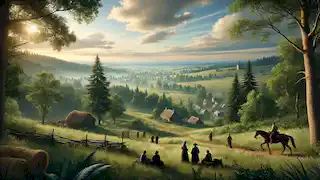In the heart of the French province of Gévaudan, during the mid-18th century, a wave of terror swept through the region. It was a time when fear and superstition were intertwined with everyday life. People whispered of a monstrous creature, a beast so ferocious and cunning that it defied capture and left only death in its wake. Known simply as "The Beast of Gévaudan," this terrifying entity became the subject of legend, folklore, and relentless pursuit. The tale of the beast has endured for centuries, blending fact and fiction, leaving behind a mystery that still fascinates historians and storytellers alike. The year was 1764, and the remote province of Gévaudan, located in south-central France, was known for its rugged landscape. Nestled among the high mountains, dense forests, and open fields, the people of this region lived in relative isolation, far removed from the grand events that shaped the rest of France. It was a simple life, one governed by the rhythm of nature and the seasons. However, the peace of the land was shattered in the summer of that year when strange reports began to emerge. Villagers spoke of a terrifying beast, unlike anything they had seen before, attacking livestock and even humans. Its size was said to be massive, larger than a wolf, and its movements unnervingly swift. Witnesses described it as having an elongated head with sharp teeth, a coat of dark, bristling fur, and a long, sinuous tail. The first victim was a young shepherdess named Jeanne Boulet. She had been tending her flock near the small village of Les Hubacs when she was brutally attacked and killed. The violence of her death was shocking, and the nature of her injuries suggested something far more vicious than a typical wolf attack. Her death marked the beginning of a terrifying saga that would span over three years. As news of the attack spread, fear gripped the surrounding villages. Parents warned their children not to wander too far from home, and men armed themselves with whatever weapons they could find. But the beast continued its rampage, striking fear into the hearts of even the bravest hunters. Over the course of the next few months, more attacks were reported. The beast struck with terrifying regularity, often targeting women and children. It seemed to prefer solitary victims, those who were alone in the fields or traveling through the forests. The brutality of the attacks was consistent—victims were often torn apart, their throats ripped open, and their bodies mutilated. The people of Gévaudan turned to their local leaders for help. The region’s governor, Jean-Baptiste d'Apcher, took the threat seriously and organized several hunting parties. Local hunters, along with villagers, scoured the countryside in search of the creature. They set traps, tracked paw prints, and even used poisoned bait, but the beast eluded them at every turn. At this point, the story of the Beast of Gévaudan began to spread beyond the province. Word of the mysterious and deadly creature reached the royal court in Paris, where King Louis XV himself became aware of the situation. Intrigued and concerned, he offered a substantial reward to anyone who could kill the beast. Despite the bounty and the efforts of the local hunters, the beast continued to evade capture. It seemed to possess an almost supernatural ability to disappear into the forests, only to reemerge days later to strike again. The people of Gévaudan were living in a state of constant fear, knowing that at any moment, the beast could appear. In early 1765, King Louis XV decided to send professional hunters to the region to deal with the problem. Among them was François Antoine, the king’s personal gun bearer and a highly skilled tracker. Antoine arrived in Gévaudan with a team of experienced hunters, confident that they could put an end to the beast's reign of terror. For months, Antoine and his men scoured the forests and hills of Gévaudan. They followed tracks, investigated sightings, and engaged in several encounters with wolves, which they killed, but none of them matched the descriptions of the beast. Nevertheless, in September of 1765, Antoine and his team killed a large wolf in the woods near Chazes. The wolf was massive, and Antoine declared that it was the Beast of Gévaudan. The body of the wolf was sent to Versailles, where it was displayed before the court. The people of Gévaudan, eager for the terror to end, breathed a collective sigh of relief. For a time, it seemed that the nightmare was over. But the killings did not stop. Just a few months after Antoine’s supposed victory, more attacks were reported. The Beast of Gévaudan was not dead, and it returned with a vengeance. The attacks became even more brutal, as if the beast was enraged by the earlier attempts to kill it. Panic spread through the region once more. As the attacks continued, so did the rumors and speculation about the beast. Some believed it to be a giant wolf or a hybrid of some sort, while others thought it was a supernatural creature—perhaps a demon or a werewolf. The people of Gévaudan were deeply religious, and many believed that the beast had been sent as a punishment from God or that it was a creature of the Devil himself. Tales of the beast spread far and wide, reaching other parts of France and even neighboring countries. Travelers passing through the region would often detour around Gévaudan, fearful of encountering the creature. Some who dared to venture through would later claim to have seen the beast with their own eyes, describing it in even more fantastical terms. The people of Gévaudan, desperate for protection, turned to their faith. They prayed for deliverance, held religious processions, and some even claimed to see visions of saints or angels who promised them protection from the beast. But despite their prayers, the attacks continued. In 1767, after more than three years of terror, the situation reached a breaking point. The death toll had risen to over a hundred, and the people of Gévaudan were losing hope. It was then that a local nobleman, the Marquis d'Apcher, decided to take matters into his own hands. D'Apcher organized a final hunt, enlisting the help of local hunters and soldiers. Among them was a man named Jean Chastel, a seasoned hunter who had been involved in earlier attempts to kill the beast. Chastel, a deeply religious man, prepared for the hunt by attending mass and carrying with him a special silver bullet, which had been blessed by a priest. On June 19, 1767, Chastel and the hunting party ventured into the hills near the village of Saugues, where the beast had been sighted. They waited in silence, their rifles ready. According to legend, Chastel knelt down and prayed as he loaded his rifle with the silver bullet. When the beast finally appeared, Chastel was the first to act. He took aim and fired, striking the creature. The beast let out a horrifying cry and collapsed to the ground, dead. The body of the beast was brought back to the village, where it was examined by local authorities. It was said to be unlike any wolf they had ever seen, larger and more fearsome. Its body was later dissected, revealing human remains in its stomach—confirming that this was indeed the creature responsible for the deaths. With the death of the beast, the attacks finally ceased, and the people of Gévaudan could at last breathe easy. Jean Chastel was hailed as a hero, and the legend of the Beast of Gévaudan was cemented in history. Though the beast was dead, its legacy lived on. The story of the Beast of Gévaudan became a cautionary tale, passed down through generations. Some claimed that the creature had been a freak of nature, perhaps a mutated wolf or the result of some strange crossbreeding experiment. Others held to the belief that it was a supernatural entity, a creature sent to punish the people for their sins. In the years that followed, the story of the beast was immortalized in books, songs, and plays. It became a symbol of the untamed wilderness and the unknown dangers that lurk within it. To this day, the mystery of the Beast of Gévaudan continues to captivate historians, scholars, and those who enjoy tales of the supernatural. {{{_03}}} The region of Gévaudan, now part of modern-day Lozère, has embraced the legend, with monuments and plaques commemorating the events. Tourists come from far and wide to explore the area and learn more about the history of the beast. Local businesses capitalize on the legend, with restaurants, inns, and shops themed around the creature. While modern-day experts continue to debate the true nature of the Beast of Gévaudan—whether it was a wolf, a wolf-dog hybrid, or something else entirely—the story remains one of the most famous cryptid legends in French history. For the people of Gévaudan, it was a time of unimaginable terror, but also a testament to their resilience and determination in the face of an almost mythical threat. Over the centuries, many theories have been proposed about the true identity of the Beast of Gévaudan. Some suggest it was a large wolf or pack of wolves, perhaps driven to attack humans due to scarcity of prey. Others believe it may have been an exotic animal, such as a hyena or a lion, brought to France by a wealthy nobleman and accidentally released into the wild. There are even more outlandish theories, such as the idea that the beast was a werewolf or that it was part of a government conspiracy. Some historians have speculated that the attacks may have been the work of a serial killer who used the beast as a cover for his crimes. While these theories add to the intrigue, none have been definitively proven. What is certain is that the Beast of Gévaudan left an indelible mark on the history of the region. The terror it inspired, the deaths it caused, and the mystery surrounding its true nature have ensured that it will forever remain one of the most enduring legends of France. Though the Beast of Gévaudan was killed more than two centuries ago, its legend continues to live on. Books, films, and documentaries have kept the story alive, exploring the many facets of the tale—from the historical facts to the supernatural theories. For the people of Gévaudan, the beast is not just a story from the past, but a part of their cultural heritage. It serves as a reminder of the dangers that once lurked in the wilds of France and the bravery of those who faced them. In the end, the Beast of Gévaudan may never be fully understood, but it remains a testament to the power of storytelling, the endurance of legends, and the mysteries of the natural world. {{{_04}}}Whispers in the Mountains

A Growing Threat
The King's Huntsmen

The Legend Grows
The Final Hunt
Legacy of the Beast
Theories and Speculation
Epilogue: The Beast Lives On
The Legend of the Beast of Gévaudan
Reading Time: 10 min

About Story: The Legend of the Beast of Gévaudan is a Legend Stories from france set in the 18th Century Stories. This Dramatic Stories tale explores themes of Courage Stories and is suitable for All Ages Stories. It offers Historical Stories insights. A chilling legend of terror, mystery, and courage in 18th-century France.

















